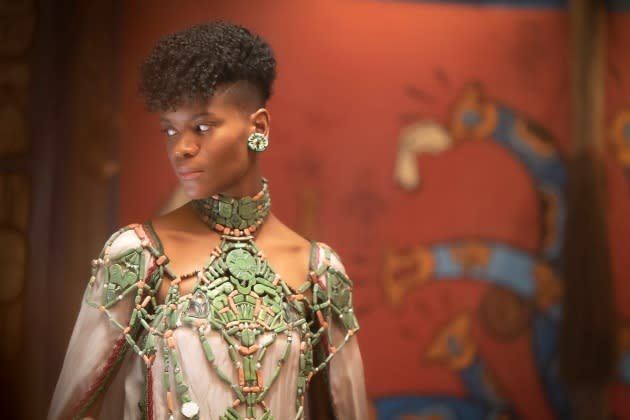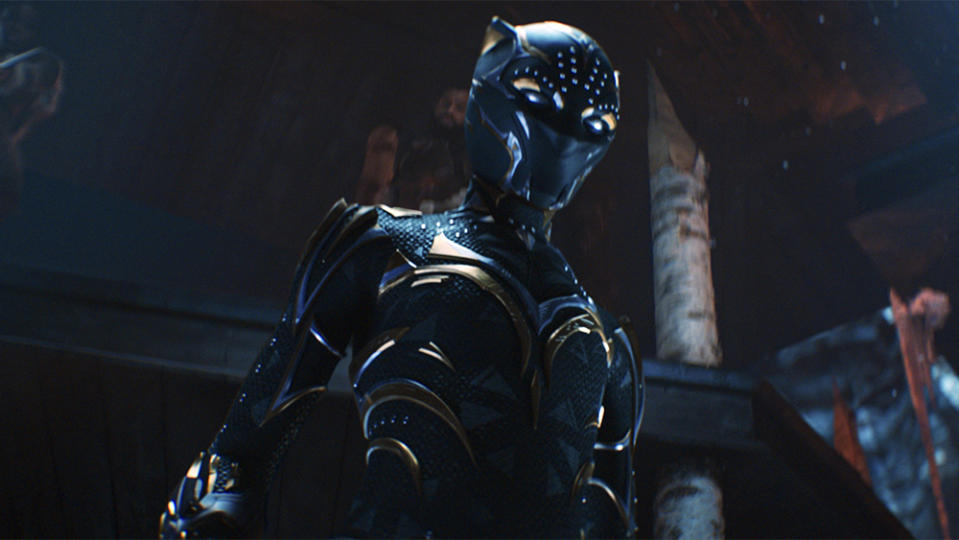‘Wakanda Forever’ Continues Marvel’s Trend of Post-Credits Scenes That Mean More to the Movie Than to the MCU
- Oops!Something went wrong.Please try again later.
- Oops!Something went wrong.Please try again later.
- Oops!Something went wrong.Please try again later.
- Oops!Something went wrong.Please try again later.

SPOILER ALERT: This story contains major spoilers for the ending and mid-credits scene in “Black Panther: Wakanda Forever,” currently playing in theaters.
At San Diego Comic-Con in July, Marvel Studios chief Kevin Feige took to the Hall H stage and for the first time delineated the grand plan for the Multiverse Saga — including that “Black Panther: Wakanda Forever,” which opened this weekend, would mark the conclusion of the Marvel Cinematic Universe’s Phase 4. That designation, however, is more symbolic than literal.
More from Variety
“Wakanda Forever” is unmistakably an extraordinary event, serving as a poignant farewell both to the franchise’s late star, Chadwick Boseman, and the stirring hero he portrayed, King T’Challa. But within the context of the Marvel Cinematic Universe, the movie does not really conclude anything. Unlike 2012’s “The Avengers” (the conclusion of Phase 1) and “Avengers: Age of Ultron” (the conclusion of Phase 2), Ryan Coogler’s film does not pull together different storytelling strands from previous MCU movies into a climatic team-up adventure, nor does it set the stage for the grander story yet to unfold.
Yes, Julia Louis-Dreyfus continues her peripatetic run as the mysterious government operative Valentina Allegra de Fontaine, who has apparently been promoted to the director of the CIA. But even as Wakanda grieves the loss of T’Challa, no other MCU superhero makes an appearance — not Sam Wilson or Bucky Barnes, not Doctor Strange or Clint Barton, not Thor or Valkyrie or Bruce Banner, all of whom have played major roles in Phase 4.
Instead, “Wakanda Forever” does what just about every other film and streaming series has done in Phase 4: Rather than knit together a cohesive storytelling tapestry, the film continues its own individual narrative while sprouting brand new branches into the increasingly unwieldy MCU multiverse. Even the post-credits scenes have shifted away from teasing future MCU movies and instead seeded new characters within each individual franchise, which is how we get Harry Styles, Charlize Theron and Brett Goldstein appearing for two seconds as major MCU characters but no MCU title to call home. (More on that in a bit.)
In the film itself, “Wakanda Forever” introduces the superpowered Namor (Tenoch Huerta Mejía) and the secret underwater kingdom of Talokan as the only civilization on Earth other than Wakanda to benefit from the wonders of vibranium. That reality puts the realms in violent opposition to each other until Namor and Wakanda’s new Black Panther, Shuri (Letitia Wright), declare a truce. At the end of the film, Namor predicts that the rest of the world’s covetousness of Wakanda’s vibranium will require the country to turn to Talokan as an ally — which sounds much more like a set up for “Black Panther 3” than anything having to do with the larger Multiverse Saga.
Similarly, the brand new character Riri Williams (Dominique Thorne) commences a storyline in “Wakanda Forever” that will continue next year on the Disney+ series “Ironheart,” which Coogler’s Proximity Media is producing with Marvel Studios.
Namor and Riri are both fabulous additions to the MCU, as are the charismatic actors who portray them, and there’s every reason to expect they could play a role in future movies beyond the “Black Panther” franchise — but how they could figure within the Multiverse Saga itself remains unclear. (Also, if anyone in “Wakanda Forever” was going to mention the gargantuan marble statue of a planet-sized Celestial suddenly appearing in the Indian Ocean — i.e. the climax of 2021’s “Eternals” — you’d think it would be Namor. But, alas, he does not, nor does anyone else. The cosmic gaslighting continues!)
And then there’s the film’s mid-credits scene, which is so sublime and moving that I’m going to warn any readers who haven’t seen “Wakanda Forever” to wait until they’ve seen the film to continue with this piece. Truly: It can wait!

OK: After spending the film avoiding her grief for her brother, the movie ends with Shuri traveling to Haiti and the beachside home of T’Challa’s beloved, Nakia (Lupita Nyong’o). Shuri sits by the water, burns her funeral garments per Wakanda custom, and finally mourns T’Challa. After the film’s main credits play, however, the movie cuts right back to Shuri on that beach. Nakia approaches, with a young boy, roughly 5 years old, holding her hand. Nakia introduces him as her son, Toussaint, the namesake of Toussaint Louverture, the former slave who led the Haitian Revolution of the late 18th century. Then Toussaint tells Shuri his Wakandan name, which he shares with his father: T’Challa.
It is a stunning moment of gentle grace that the MCU has rarely had room for. The scene also suggests further complications for “Black Panther 3,” given the somewhat confusing way “Wakanda Forever” ends with M’Baku (Winston Duke) making a play for the throne, seemingly with Shuri’s blessing. Astute MCU observers may also note it is yet another member of young superheroes-to-be that have been a constant since Phase 4 began: Billy Maximoff (Julian Hilliard) and Tommy Maximoff (Jett Klyne) on “WandaVision,” Eli Bradley (Elijah Richardson) on “The Falcon and the Winter Soldier,” Kid Loki (Jack Veal) on “Loki,” Kate Bishop (Hailee Steinfeld) on “Hawkeye,” America Chavez (Xochitl Gomez) in “Doctor Strange in the Multiverse of Madness,” Kamala Khan (Iman Vellani) on “Ms. Marvel” and Love (India Hemsworth) in “Thor: Love and Thunder.”
Perhaps most tellingly, however, the “Wakanda Forever” post-credits scene ends Phase 4 with absolutely zero indication as to what lies ahead for Phase 5 or Phase 6: There is no equivalent of Thanos smirking over his shoulder or Nick Fury activating his Captain Marvel pager. Instead, it’s a quiet scene of a family beginning to mend its ragged emotional wounds through the promise of a new generation.
Best of Variety
Sign up for Variety’s Newsletter. For the latest news, follow us on Facebook, Twitter, and Instagram.

